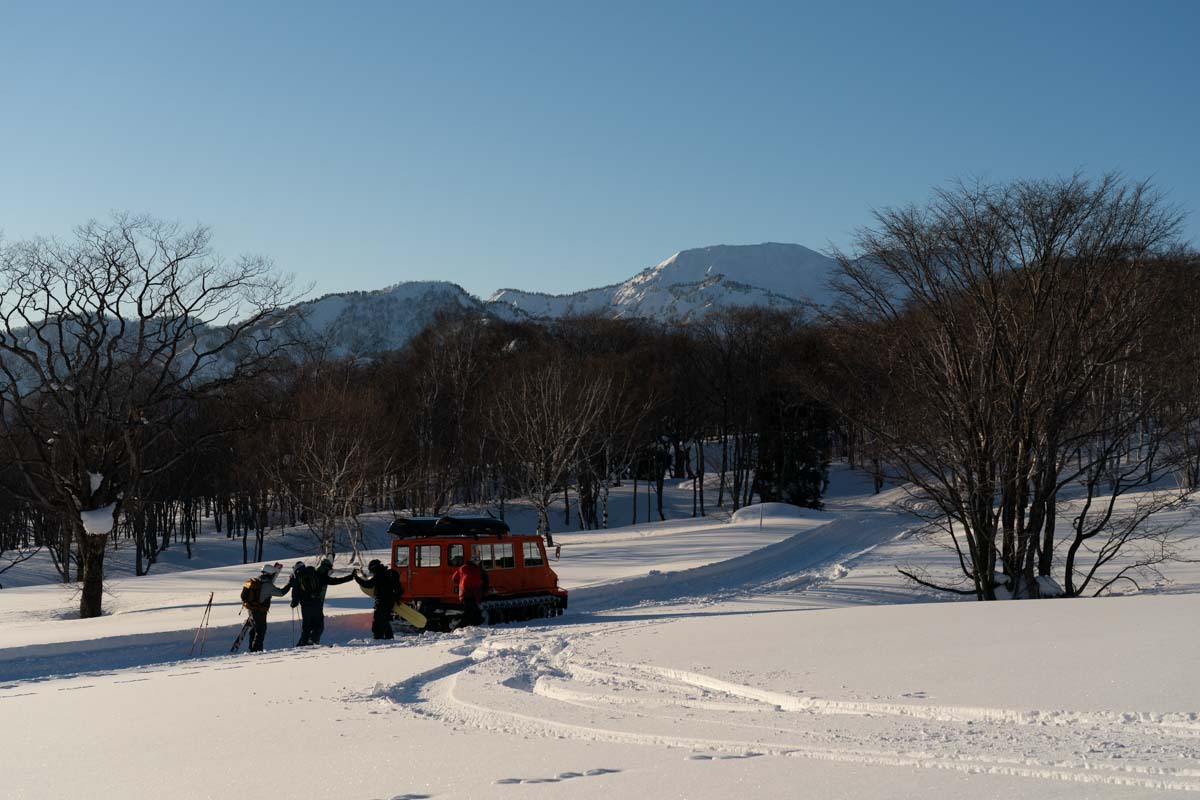A new and unique snowcat tour service will start in Myoko Kogen, which is known for its heavy snowfall.
In addition to three of Japan's leading large-scale ski resorts, there is also a classical ski resort known for deep snow lovers, albeit small. Myoko Kogen is popular as one of Japan's leading snow resorts, including the vast backcountry fields that surround it. Among them, "Thunderbird Cat Tour Myoko" is aiming for the grand opening next season (2021-2022 season) with new ideas and ideas that have never existed before. We covered the experimental pre-season tour.
Two types of cat tours are newly introduced in the former ski resort site and the Sasagamine area
"Thunderbird Cat Tour Myoko (hereinafter referred to as SBCT)" is preparing for business in two areas in Myoko Kogen.
One is the Myoko Panorama Area. Cat skiing on the site of the former Myoko Panorama Park ski resort behind Myoko Kogen Station. A tour where you can ride a snowmobile on a steep slope and ski repeatedly.
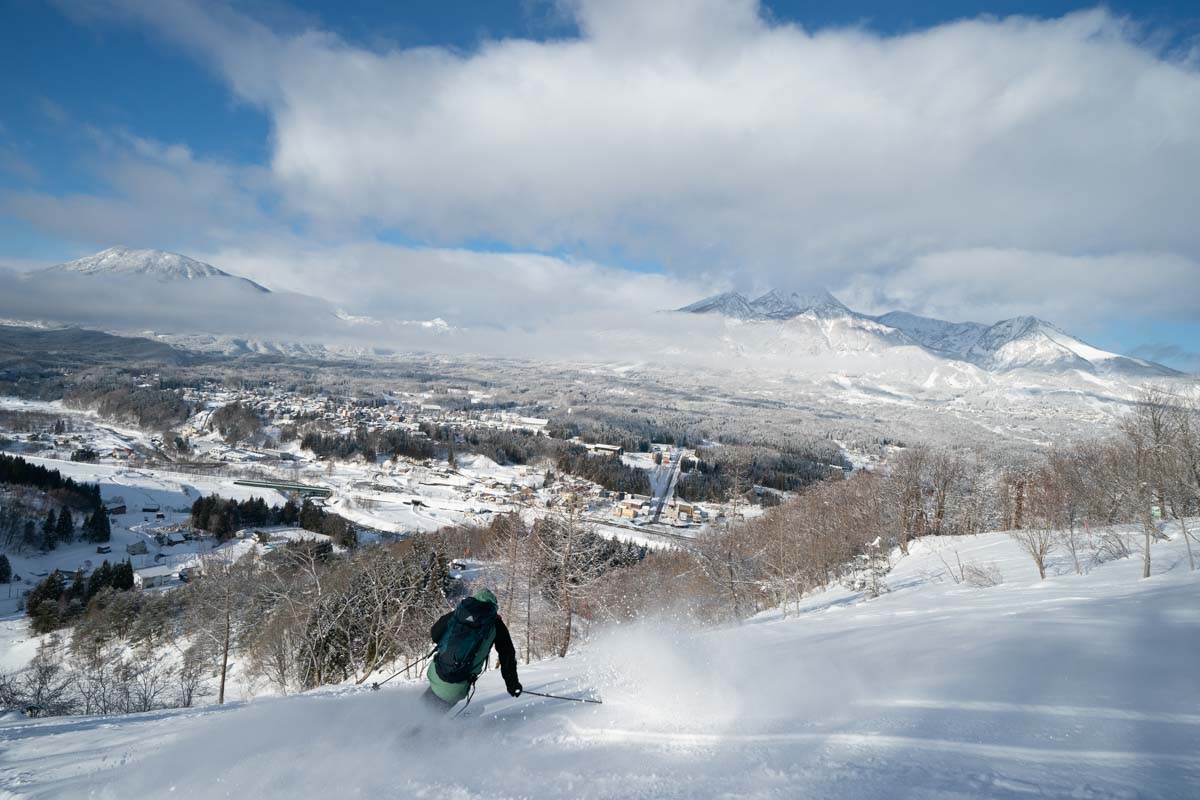
The other is the Sasagamine Plateau area. It may be an unfamiliar name for slippers, but it is located at the foot of the southwestern slope of Mt. Mitawara, the outer rim of Mt. Myoko. Can you imagine the hinterland around the Myoko Suginohara Ski Resort to the south?
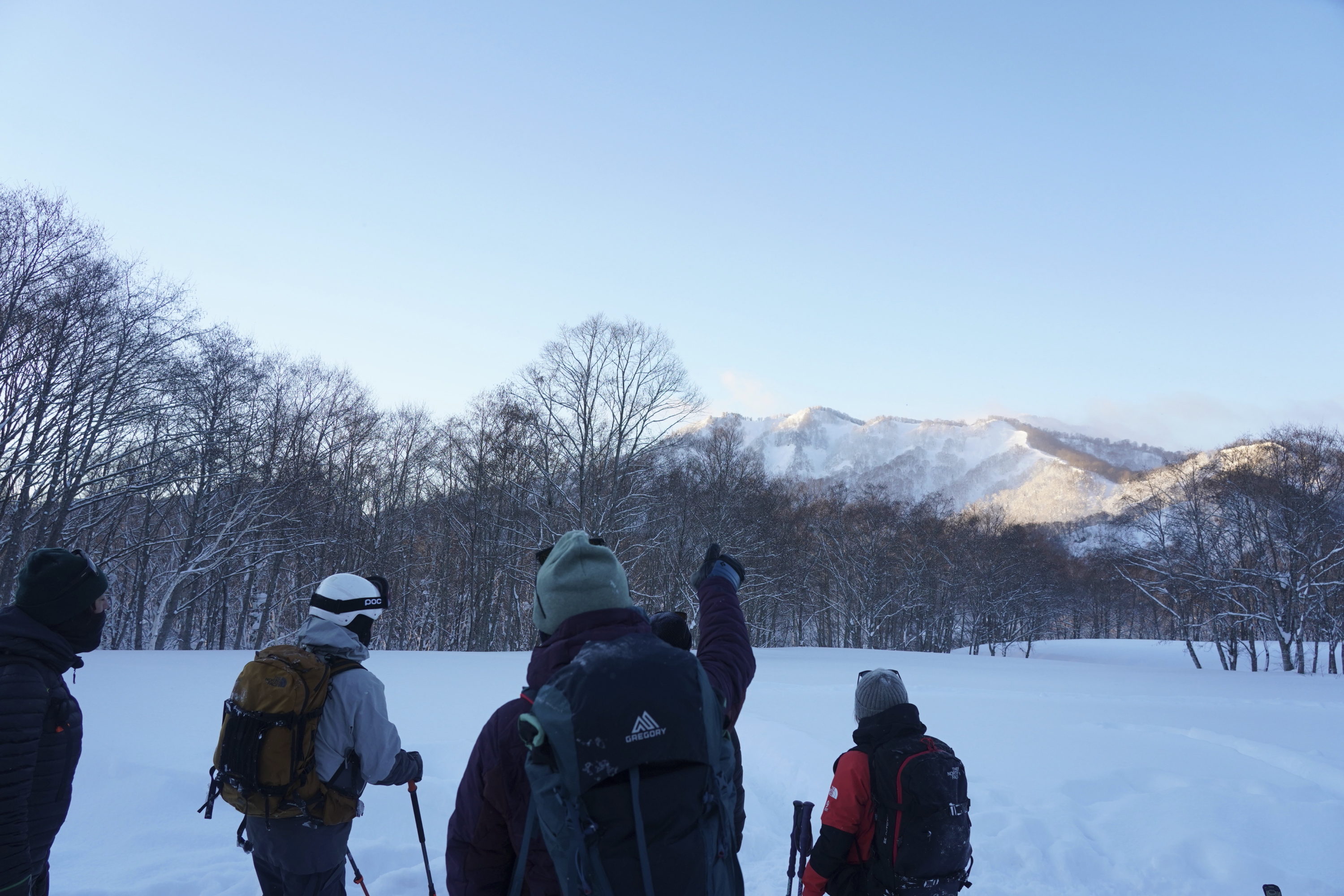
Sasagamine is a highland area with an altitude of 1,300m, where pastures and campsites spread by the lake. Many people visit during the green season, and it is also popular as a starting point for climbing Mt. Hiuchi. However, during the winter season when the roads are blocked by snow, it is a silvery white wonderland where no one can be seen. The biggest feature is that you can enjoy snow activities unique to this season, such as backcountry tours and snow camping, in a virtually chartered state by approaching here with a snowmobile.
This is how "Thunderbird Cat Tour Myoko (SBCT)" was born.
SBCT was founded by American-born Mark Ryan. Since he was young, he has traveled to ski areas all over North America, and is also a natural skier with experience as a heli-ski operations staff at Girdwood, Alaska. Ryan was fascinated by Japan ever since he first came to Japan as an exchange student when he was a student, and has spent his life traveling back and forth between North America and Japan.
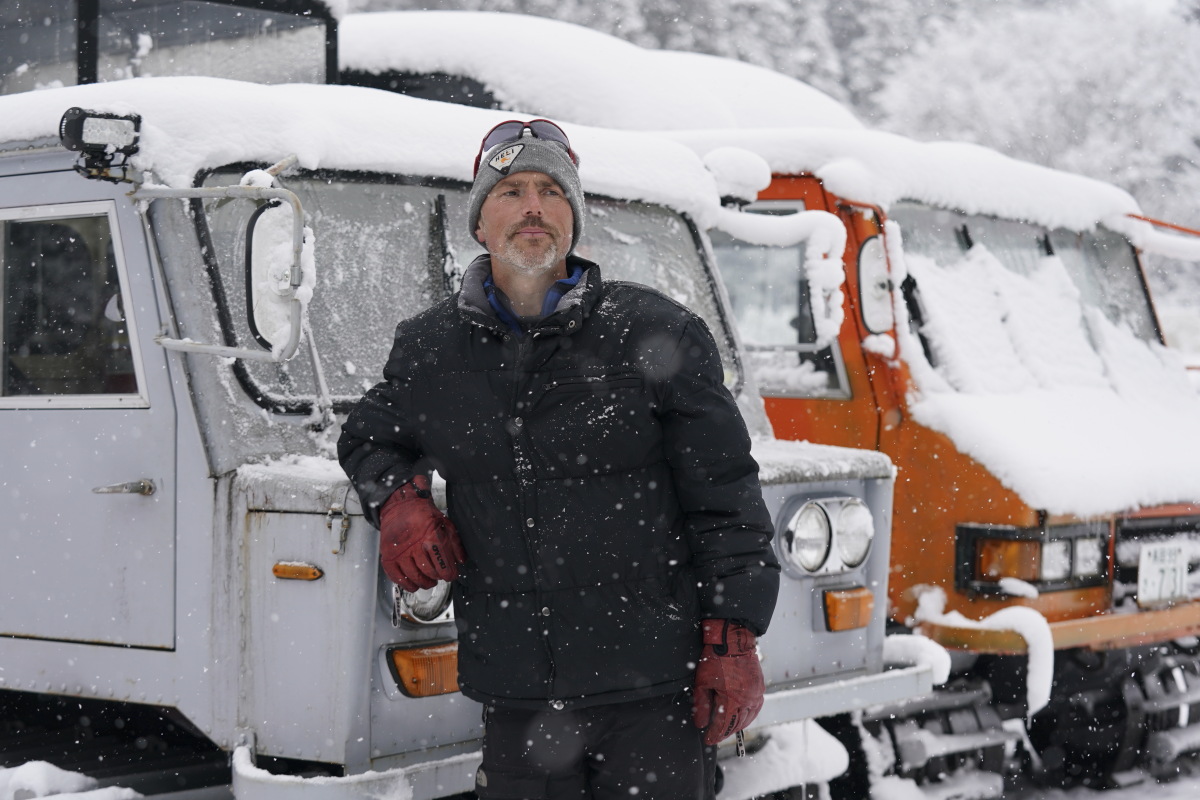
Five or six years ago, Ryan decided to move to Myoko Kogen. The biggest reason was the deep powder that was reset almost every day.
"I've skied powder all over the world, but I don't know of any other place that has such an abundance of snow falling every day and resetting the next day after skiing. That is the biggest reason why I moved to Myoko Kogen, which I have visited repeatedly.”
In recent years, Myoko Kogen is no exception to the popularity of inbound tourism. Even though it was called Myoko, there was no time to relax and enjoy the powder.
In the midst of such a whirlwind, Ryan said he had an idea in his head. If I could set up a cat tour somewhere in this vast Myoko area, I would be able to enjoy the powder in a more relaxed manner, and I would be able to convey the charm of Myoko's powder, which I love so much. .
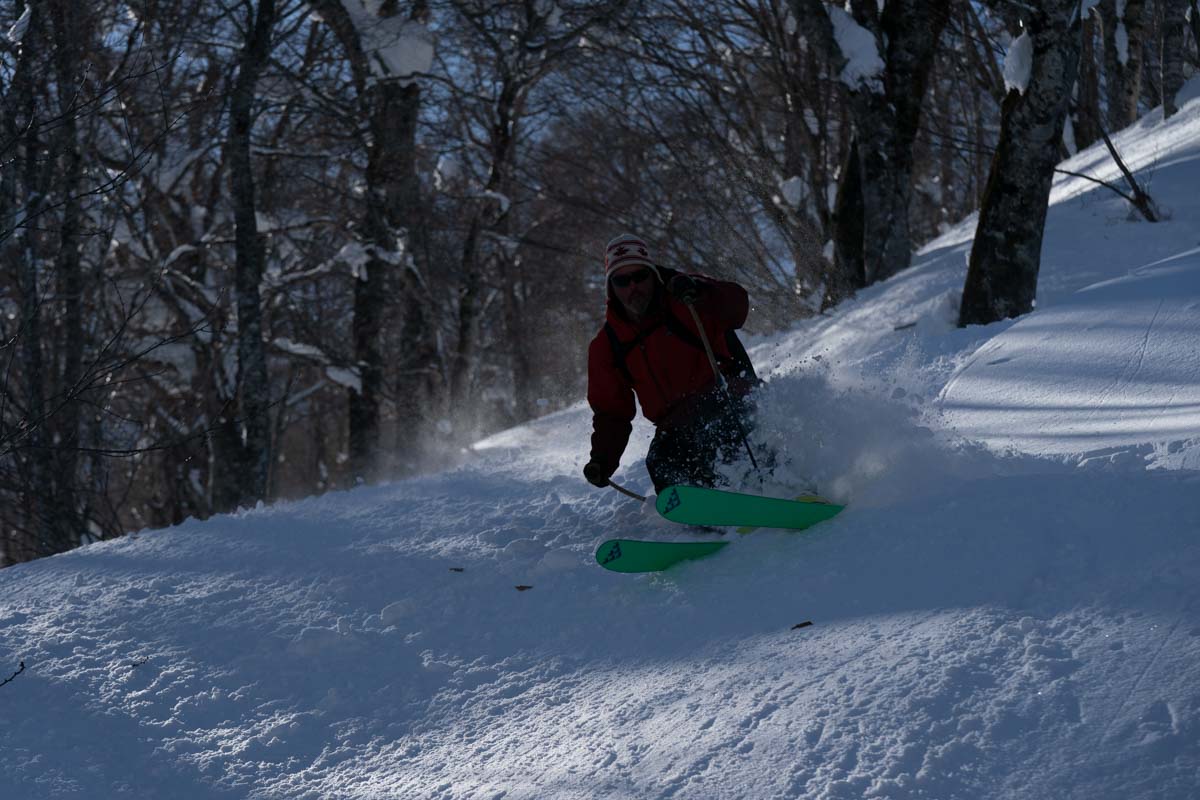
There is a reason to dare to feature a classical small snowmobile
Another reason behind Ryan's idea of cat tours is that he himself was the owner of a small snowmobile. Ryan, who has always loved riding and maneuvering, got a used small snowmobile in good condition by chance. The SM-30 made by Ohara Iron Works, known for its "Ratrack" snow groomer.This snow vehicle was produced in the 1970s and was once used in the Antarctic wintering expedition. It is a snow vehicle.
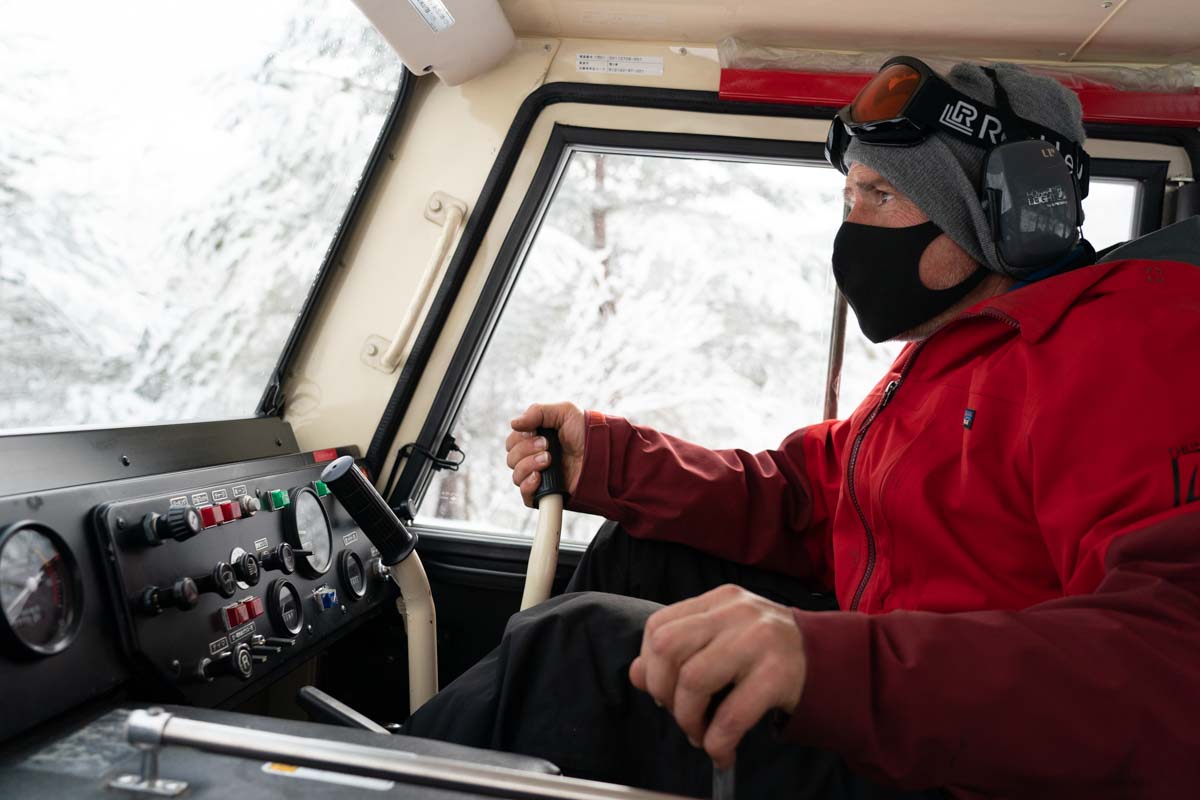
Back in the days when the roads in Myoko Kogen were not yet cleared of snow, the snowmobiles were used for transportation between Akakura and Tsubame Onsen, as well as transportation to and from lodging facilities on the slopes. It's 50 years old, but you can still see it working in the lodges next to the slopes of Akakura Onsen and Myoko Suginohara Ski Resort.
The greatest feature of this compact snow vehicle, the SM series manufactured by Ohara Iron Works, was its excellent lightweight design. Unlike snow groomers on the slopes, there are no blades or mills, and the power of the engine is not large. Still, it's small and light, so it runs briskly in any place and is controllable even in tight forests. If the snow groomer at the ski resort is a heavy and luxurious Land Cruiser, this is a light Jimny that every family wants. Ryan said he was fascinated by this vehicle.
“For example, today’s snow groomers like the Pistenbully have complicated mechanics and are full of advanced electronic boards, no matter how small they are. I can fix minor problems by myself.It's a 50-year-old vehicle that's not much different from my age, but if you drive it well, it will still work well.And it's an era like this.I take care of old tools. It feels good to keep using it for a long time.”
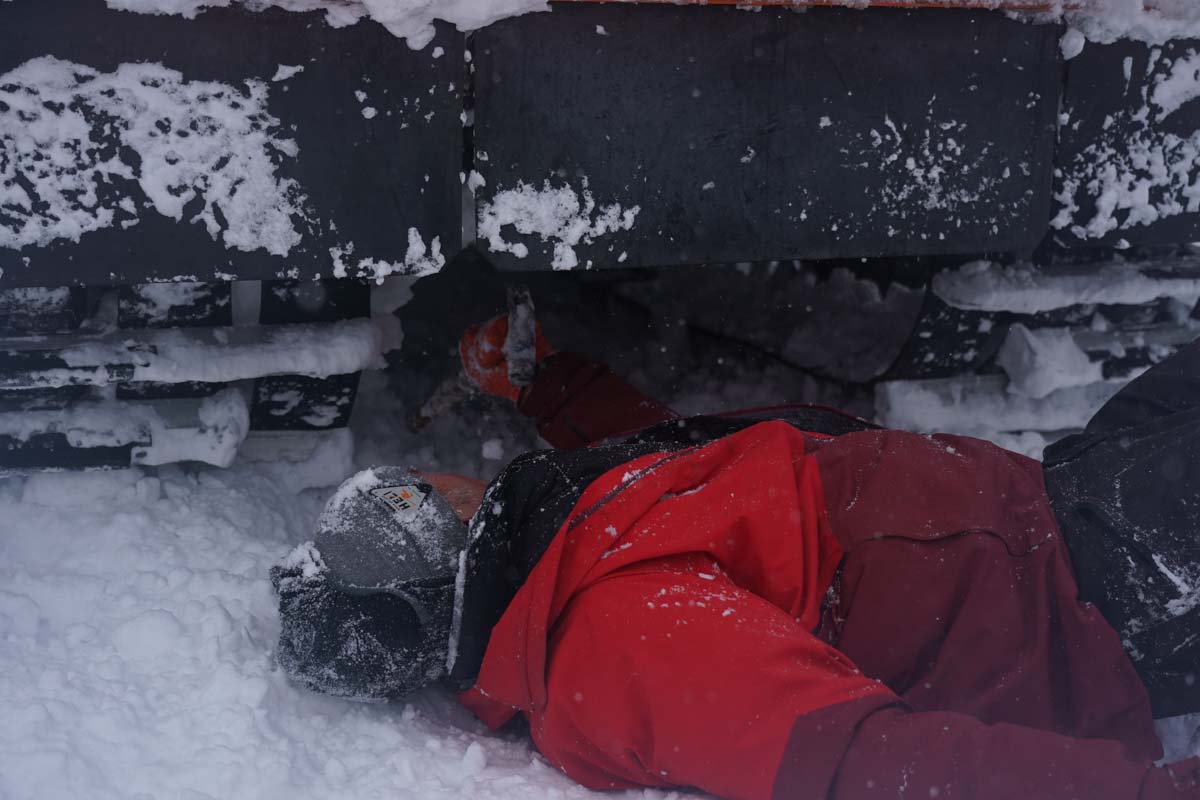
Possibilities expanded through collaboration with proven ski guides
After many hardships, Ryan obtained the right to operate a cat tour on the site of the former Myoko Panorama Park ski resort, and then asked Toyokazu Nakano, the representative of Infield, a ski guide in Myoko with whom he was an old friend, for cooperation. do. By welcoming a veteran guide who is familiar with the Myoko mountain range to the team, we wanted to consider various possibilities, including the selection of new tour candidate sites, not limited to the Myoko panorama.
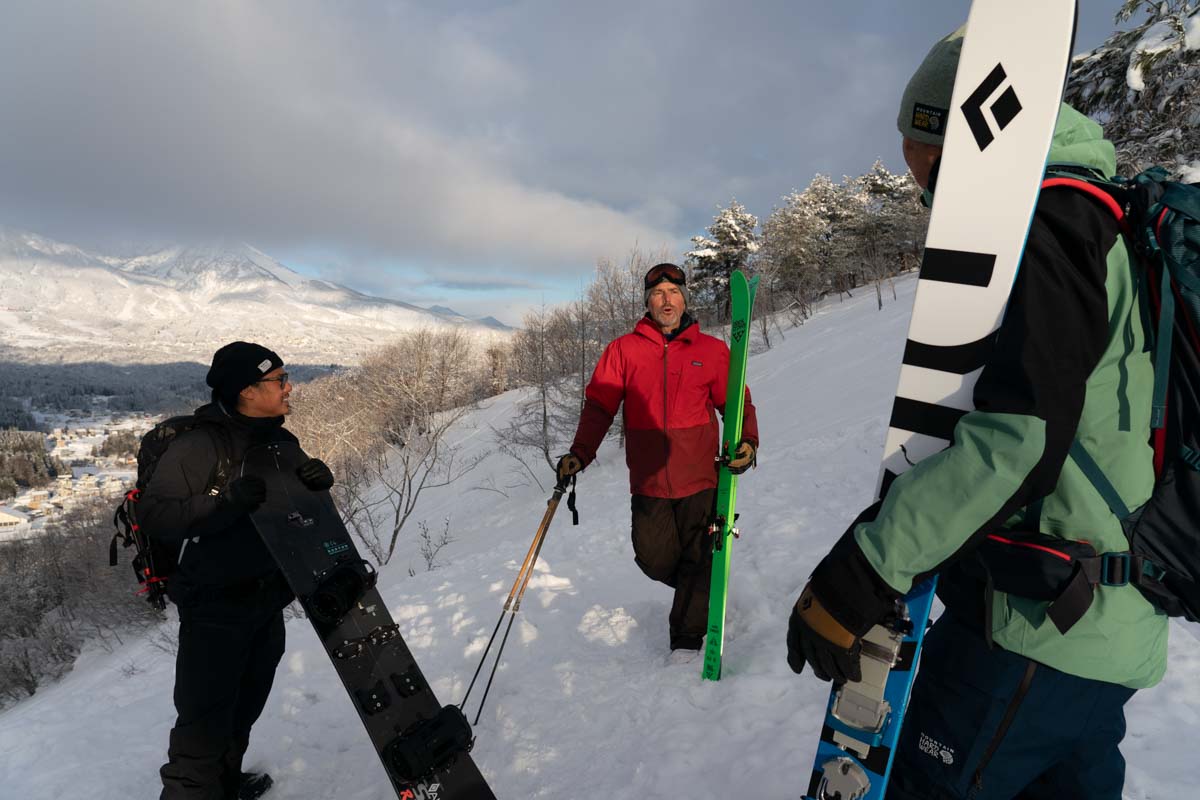
Mr. Nakano is an experienced mountain ski guide certified by the Japan Mountain Guides Association, and is currently in a leadership position in the Ski Guide Stage II qualification, and is a director of the Japan Avalanche Network and the Japan Telemark Ski Association. Since 2006, based in Myoko, he has been a backcountry ski guide in the winter and a mountaineering guide in the summer.
While participating in the operation of Myoko Panorama Park, Mr. Nakano envisioned various possibilities under the theme of using cats in the Myoko area. On top of that, I found the highest potential was a tour to the Sasagamine Plateau area, which is another pillar of SBCT.
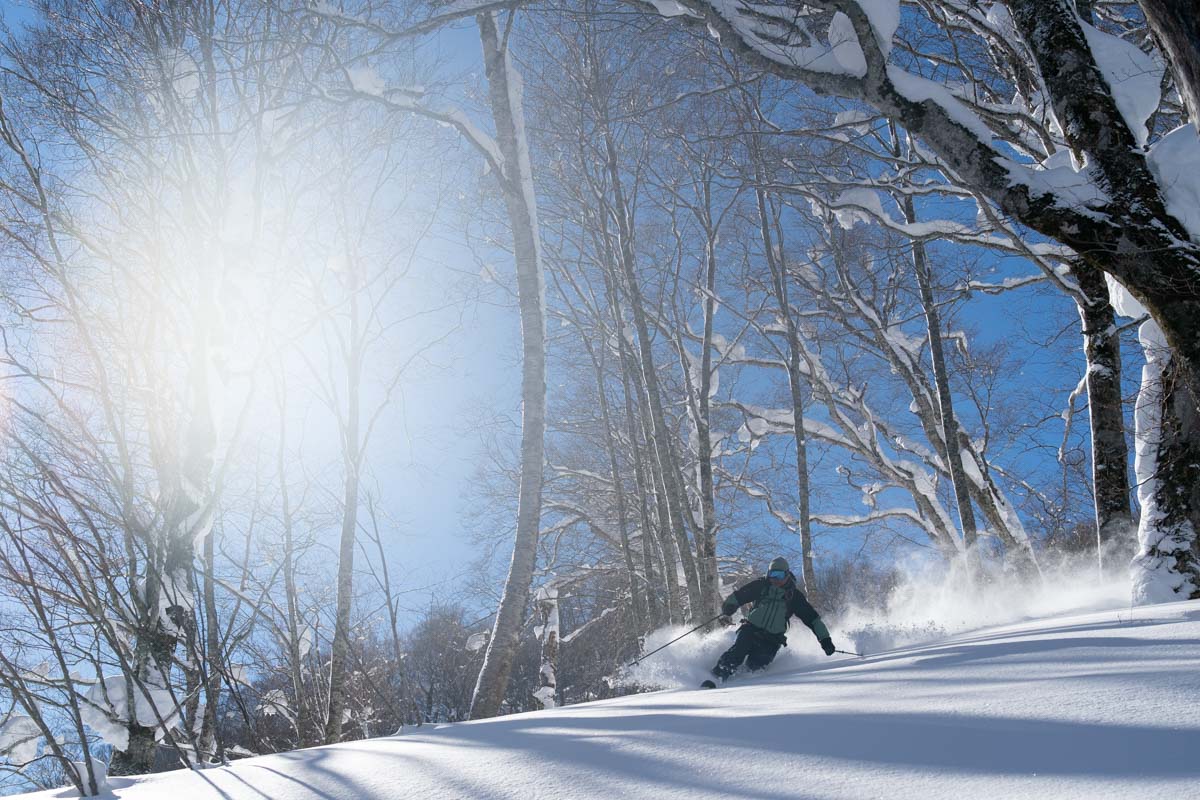
“At Infield, in the spring, when the roads are cleared of snow up to Sasagamine Ranch, we have held tours for experts who stay overnight in tents and approach more inland mountains. If you use a cat, you can approach Sasagamine even in the coldest of winters, and the conditions for participating in tours are greatly expanded.There is also a great advantage in terms of equipment.You don't have to worry about the weight of the tents and food you bring in.In other words, , You can bring in a comfortable large base camp tent and enjoy elaborate meals.Moreover, the area around Sasagamine is still unexplored because it was an area that was not open to people in winter. There are plenty of slopes, and my expectations grew, thinking that the possibilities would expand at once.”
First, I participated in a cat tour at the former Myoko Panorama Park
Those of you who are familiar with the JR Spur-go ski train may remember this ski resort that you can see right in front of you from the platform of Myoko Kogen Station. It was a small slope with several short single lifts, but at the top there was a directly managed hotel that boasted a panoramic view of the entire Myoko Kogen, and it was very crowded during the bubble period. It closed its business in 2003. Since then, it has not been revived as a ski resort, and after the snowfall, local enthusiasts seemed to enjoy hiking up and skiing.
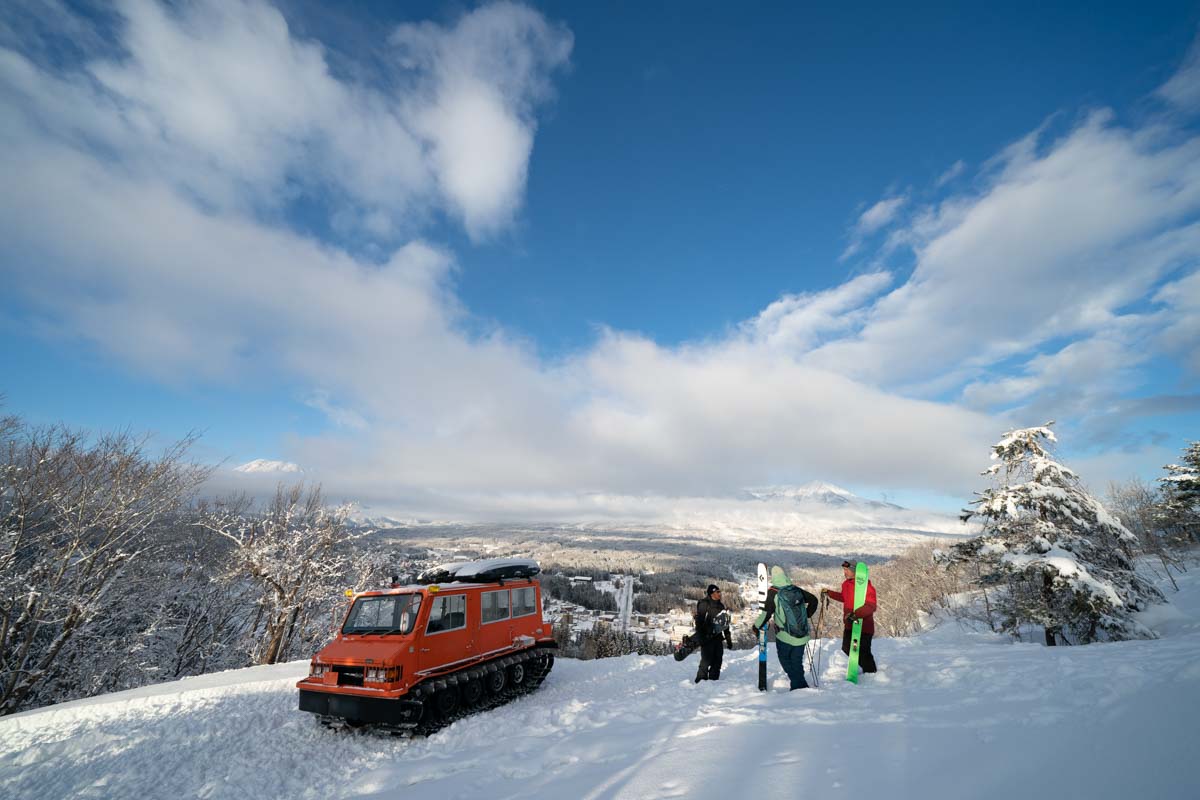
The SBCT Cat Tour starts from a point overlooking the main barn, close to Myoko Kogen Station. After a lecture from the guide and a beacon check, put the skis, poles, and snowboard in the roof bag and immediately board the Ohara SM-30. The interior cannot be said to be spacious, but this is also because the advantages of a compact and lightweight design are prioritized. In addition, we are focusing on measures against infectious diseases, such as installing a ventilation system and clear sheets inside the car.
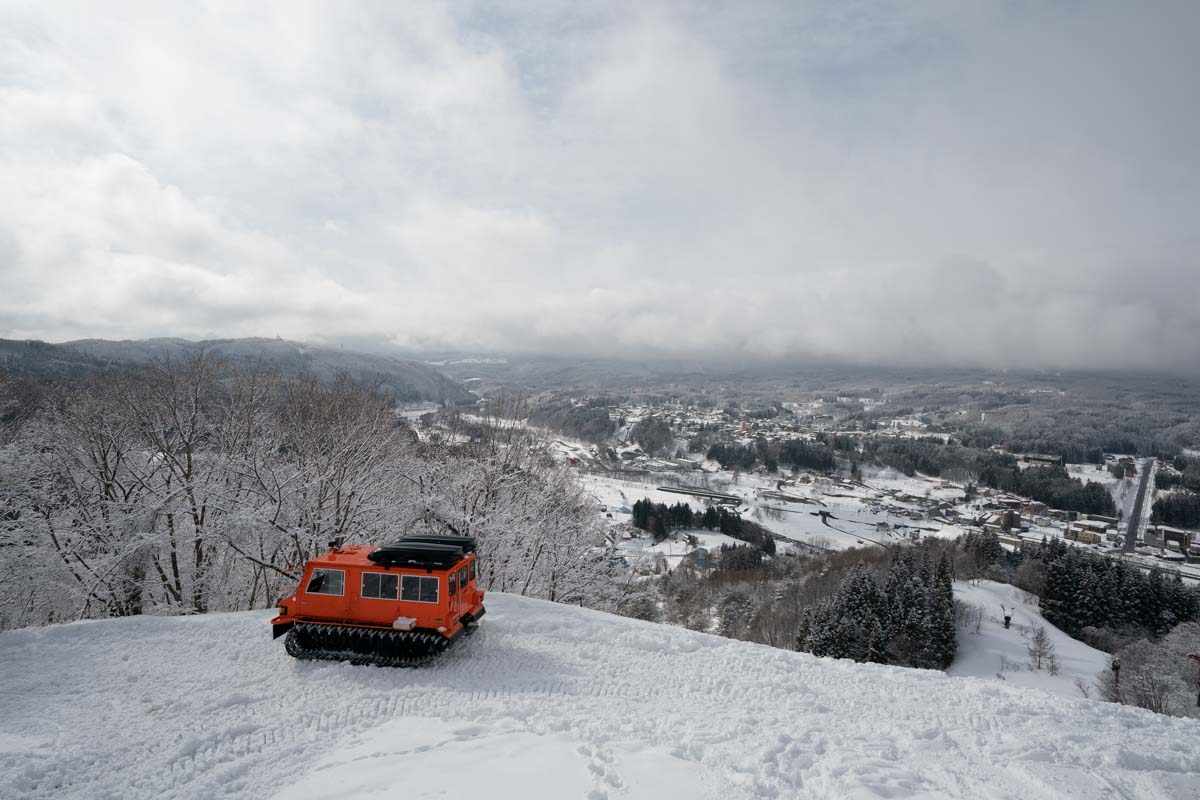
After about 20 minutes of climbing the rugged, rugged forest road of the Chinese pine forest, you will reach the peak. The ruins of the Panorama Hotel ruins still remain today, but if you pass through the sparse forest on a gentle slope from there, a large slope spreads out in front of you. This will be the main burn. From the beginning to the middle part, the slope is about 30 degrees or so. After passing through there, a comfortable powder cruise to the orange snowmobile waiting at the bottom awaits.
SBCT Myoko Panorama Cat is recommended for such slippers
The Myoko Panorama Cat Tour routine repeats this run from early in the morning to 4 and 5 runs over half a day, with the guide's coordination and line selection. On this day, the snow was moist and wet after a few days of snowfall. That being said, the difference in altitude is 150 to 200m, which is about the same as an average medium-to-steep slope in today's ski resorts, so it may be a little unsatisfactory for those who are experts in the backcountry.
However, it's perfect for those who want to enter the backcountry, or for powder lovers who don't want to hike even one step. Above all, we can monopolize this one burn without anyone getting in the way. Also, if the conditions are favorable and you can see the Myoko Kogen surrounded by Mt. Myoko, it will definitely be an unforgettable experience.
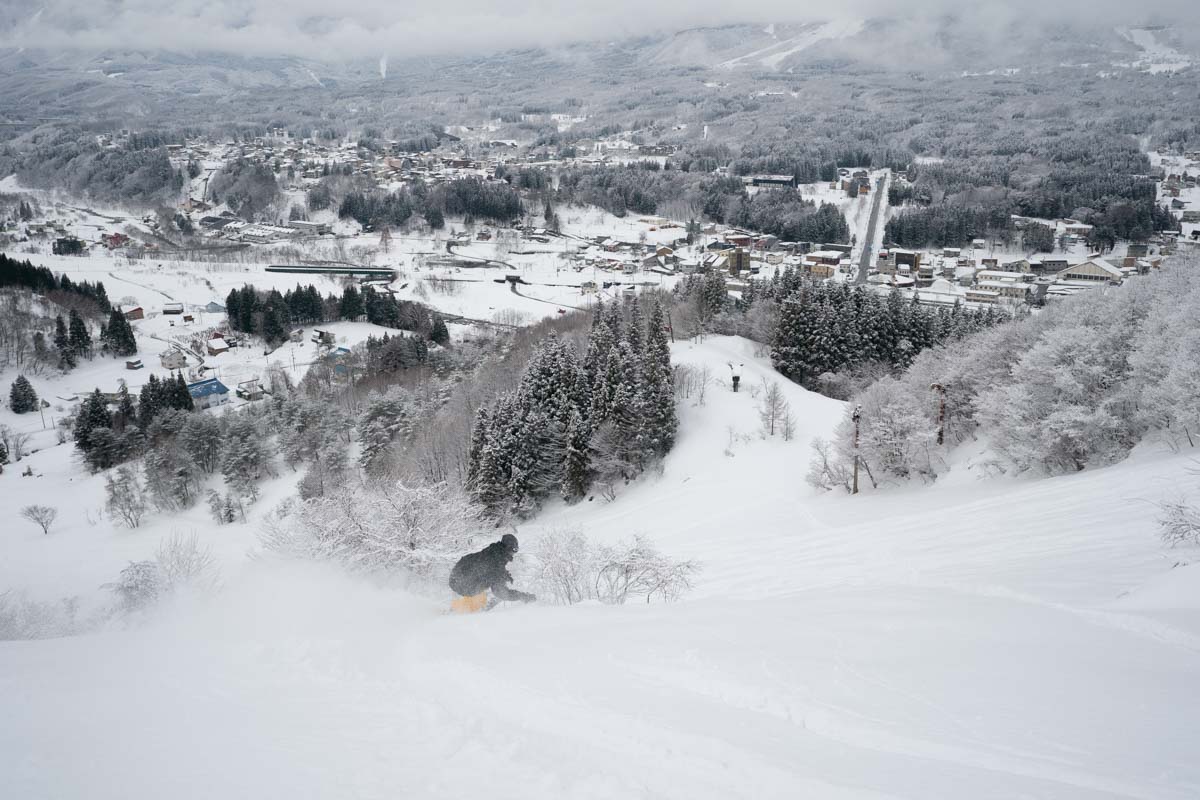
The altitude itself is not high, so the morning after a lot of snow in the high season from January to February is a chance, but that is a big problem. At the Akakura Kanko Hotel Ski Resort and Seki Onsen Ski Resort, will you line up on the lift before the start of the day and participate in the fierce fast track battle? Or, as if to ridicule the hustle and bustle, did Panorama Cat smile at the relaxed Miyuki? You must be in a lot of trouble.
Sasagamine Kogen Cat & Snow Camp Tour for 3 days and 2 nights has started
The other pillar of the SBCT, the Sasagamine Kogen Cat Tour, starts from the parking lot in the Myoko Suginohara Ski Resort Suginosawa Minshuku area. The two Ohara SM-30s, which had finished warming up, are loaded with luggage and the engine sounds loud as they begin to climb the slopes.
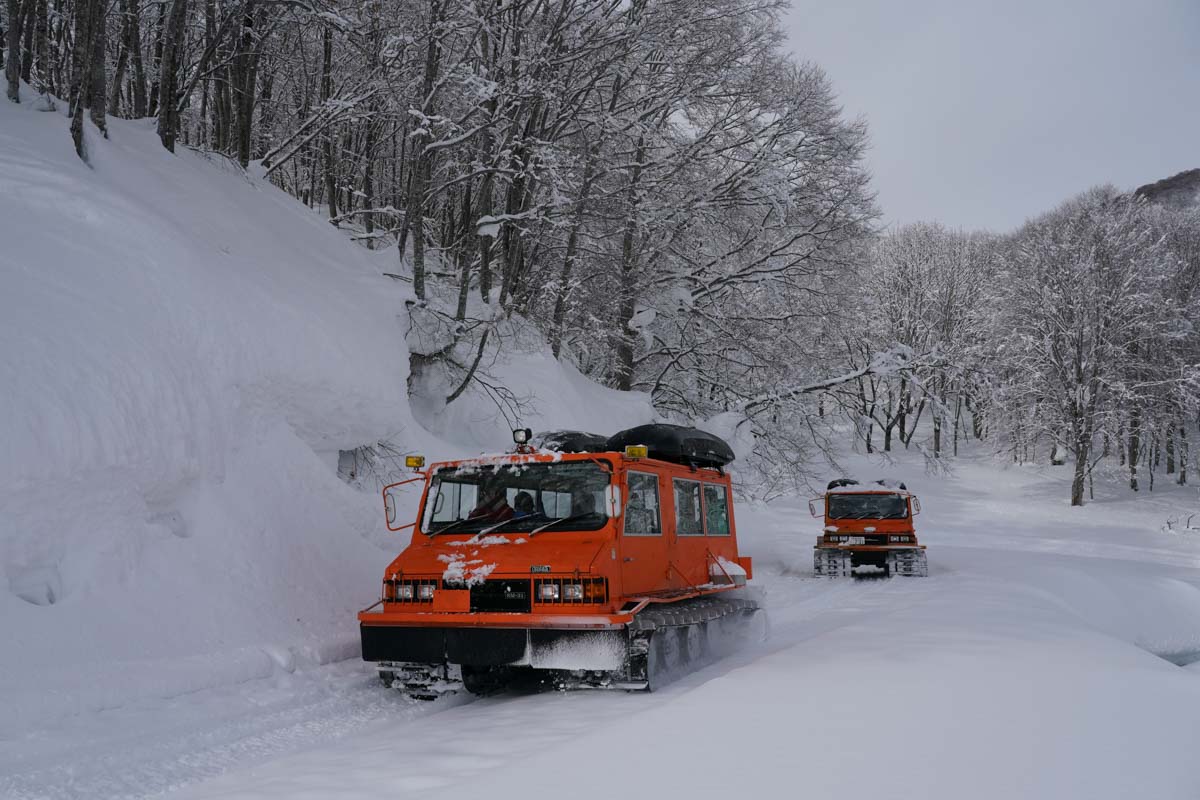
For a while, the snow vehicle goes up a undulating zigzag along the slopes of the Myoko Suginohara Ski Resort, then along the bottom of the panorama slopes it makes a big left turn and advances through the beech forest. About 30 minutes so far. You'll get used to the noise and vibrations that are unique to snowmobiles, and you'll gradually feel excited as the scenery changes rapidly.
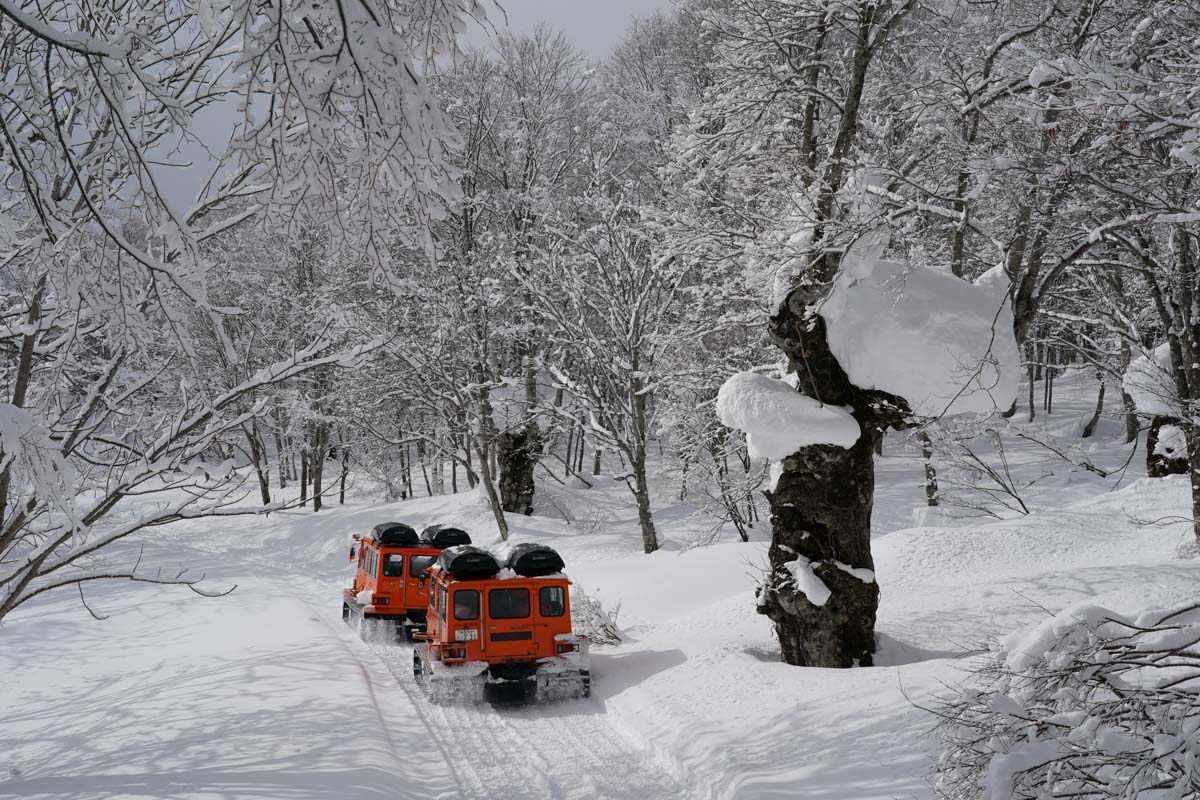
After driving through the beech forest for a while, the scenery changes completely, and the gentle highlands of Sasagamine and the white mountains behind spread out in front of you. It was just a ride for the approach to the backcountry, but from around this time, I started to realize the unique charm of traveling on a snowmobile. Let's call it the pure pleasure of traveling on a snowmobile. For some reason it's fun just to get on and move.
I have experienced various cat tours in Japan and overseas, but this is the first time I have experienced such a feeling. It's a feeling you'll never get in a gorgeous cabin on a large piston bouley. Because the vehicle is small and simple, the driving feeling that is integrated with the snowy world outside is extremely fun. For example, it's similar to the feeling of driving on a snowmobile.
A snow camp in the midwinter that sticks to full-fledged mountain specifications
After a two-hour ride from the Suginosawa parking lot, we arrived at the planned base camp site in Sasagamine Kogen. From here, we start setting up the campsite by stepping on the snow. By the time next season's operations begin in earnest, the staff will have already completed all the settings, including transporting equipment and food and setting up tents.
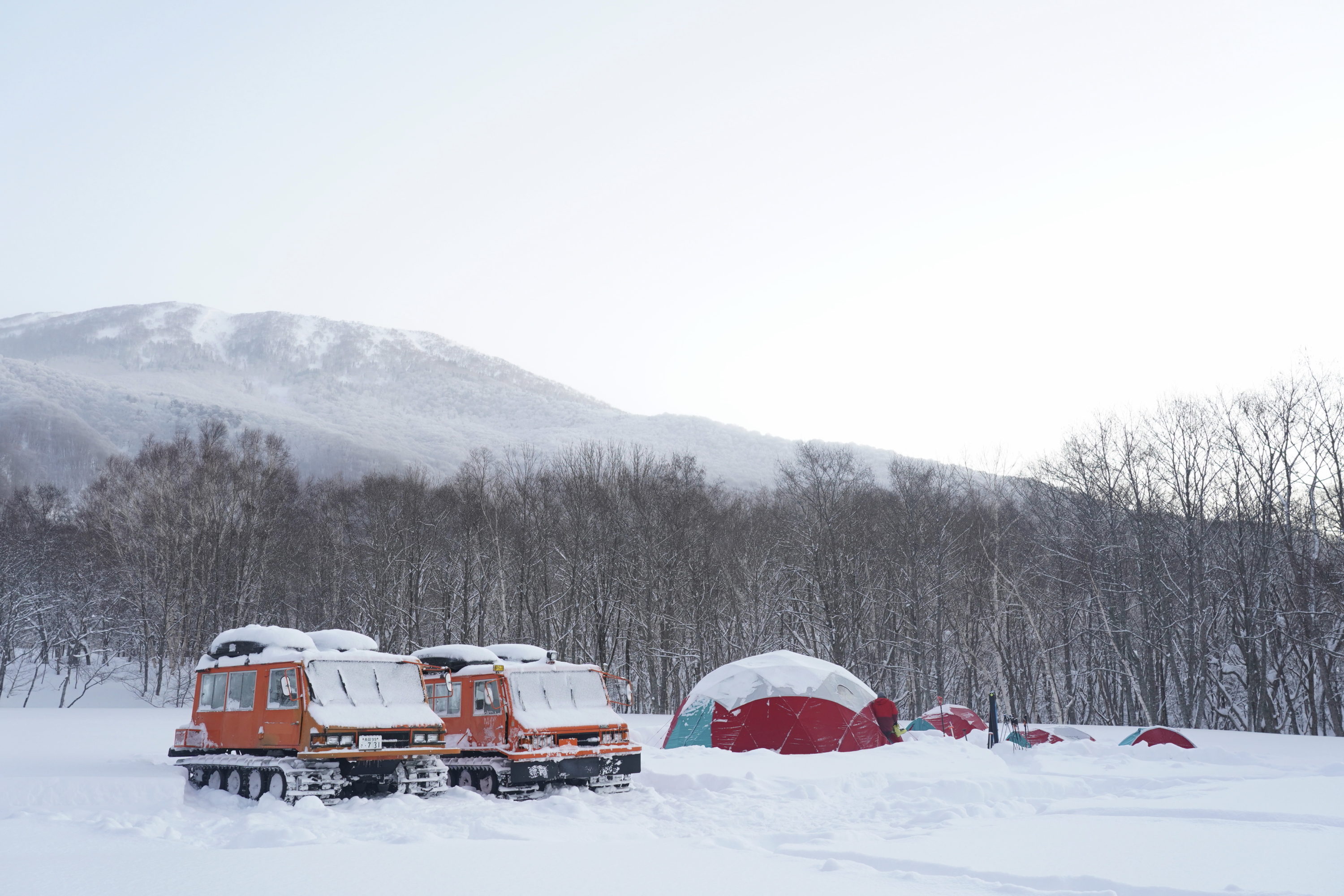
However, it might be nice to have an option menu to dare to participate in tent construction. Using the pure white snow as a canvas, laying out the necessary elements such as dining tents, individual tents, ski storage areas, and toilets in a functional and beautiful manner is the real pleasure of the first day of snow camping.
At SBCT, Mountain Hardware has prepared a super large megadome tent "Space Station" developed for polar expeditions as a base camp kitchen and living tent. With a height of 2.57m, a diameter of 5.8m and a floor area of 26.3m2, the world's largest base camp tent is comfortable. Even if it's a blizzard outside (actually, it was a terrible blizzard on the first night), there's nothing to worry about inside.
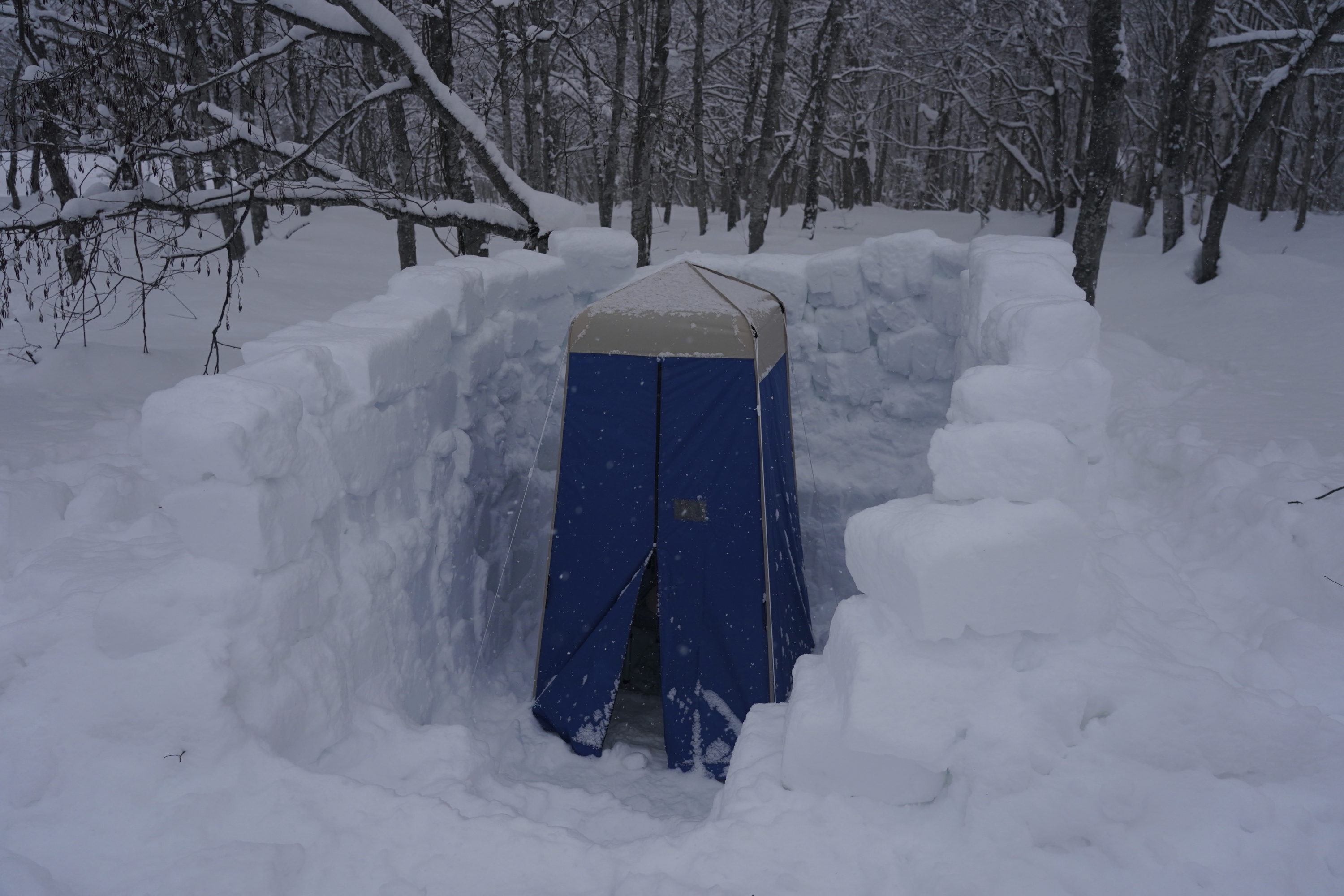
Also, for those who don't have a winter tent and sleeping bag, preparations are underway to make the same Mountain Hardwear products available for rent. A special tent is also built for the toilet, and it is a system that you can bring back with you in a portable sanitary bag, so it is warm, comfortable, and safe. The biggest stress during snow camping should be solved with this.
However, when it comes to luxurious equipment, it is not possible to expect glamping-like gorgeous equipment, and even camping goods such as a two-burner, BBQ stove, and trendy wood stove for tents are avoided, and can only be used for hardcore winter mountain climbing. Action equipment is used. Mr. Nakano, our guide, said.
“We don’t want the SBCT snow camp to be like glamping. Rather than that, what we are thinking about is a basic snow camp with basic winter mountain equipment plus alpha so that you can experience the nature of the depths of winter.
We would like you to dare to experience and enjoy the overall life of a snowy mountain stay, such as how to choose and wear clothes and winter clothes, such as making meals. I think that the best part of snow camping is actually in that point. Also, I think it will be useful when we go camping on the snow by ourselves someday. Of course, I'm open to advice. Also, our guides will take care of the food and drink, and we'll have some fun for you, so please look forward to that."
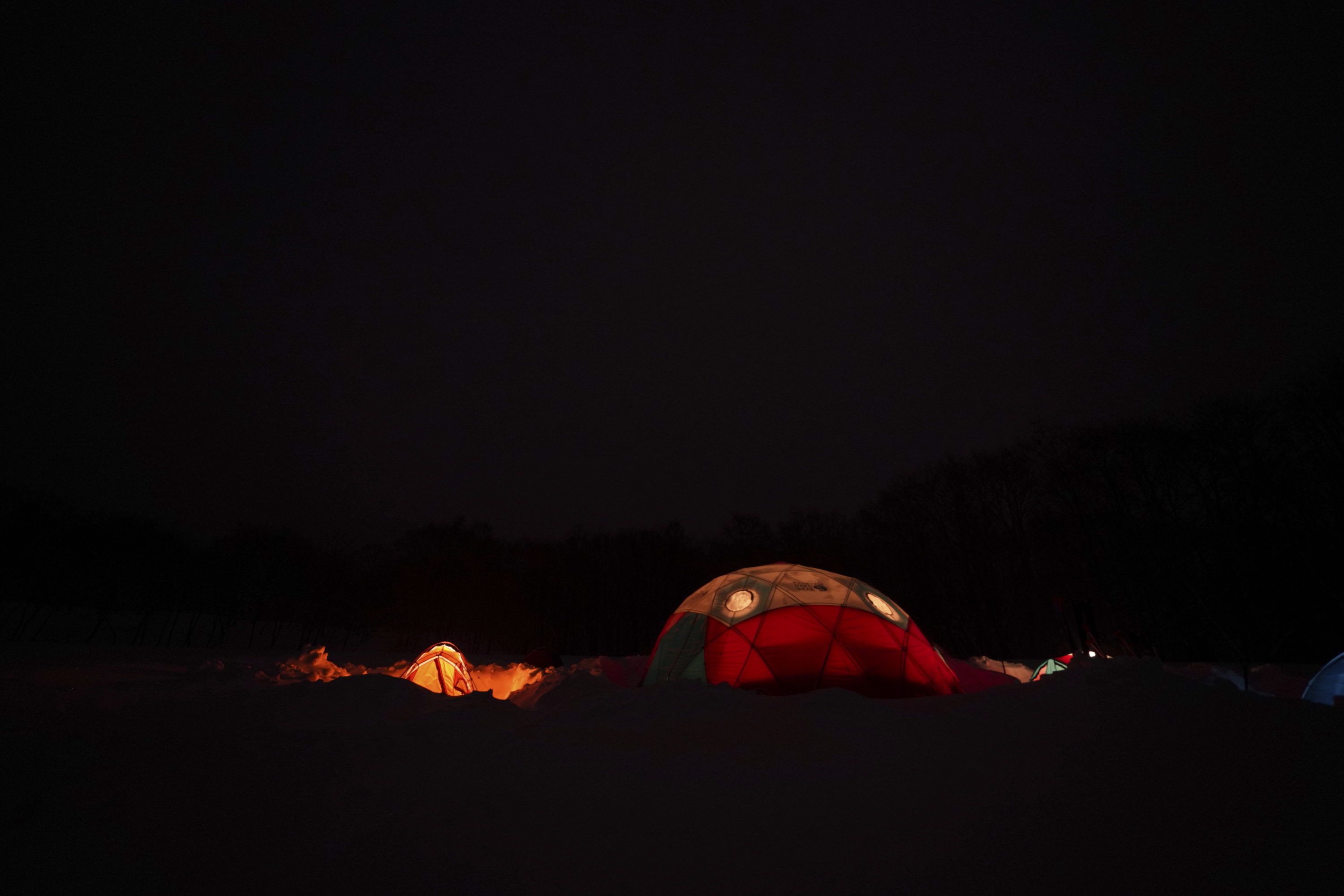
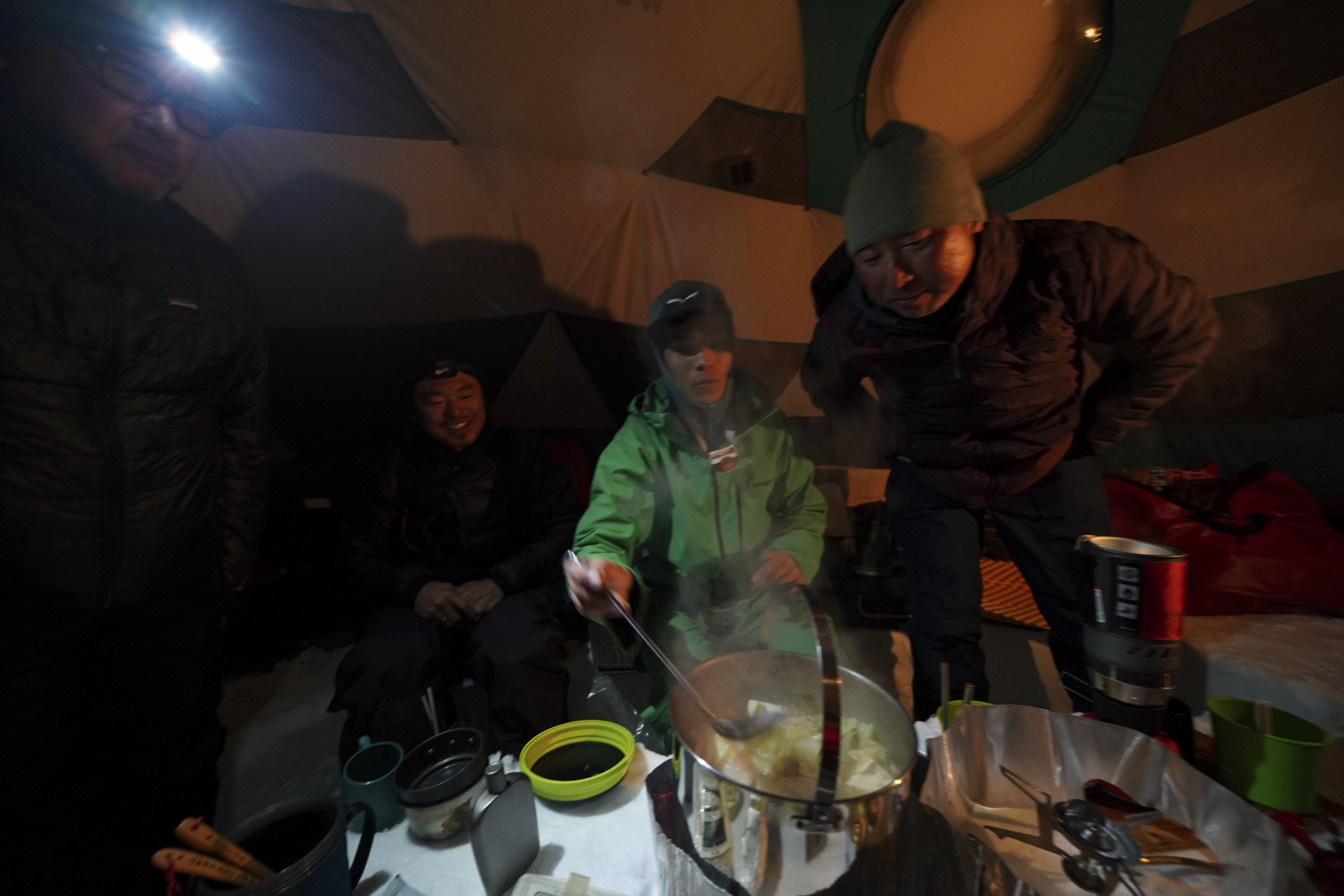
SBCT Sasagamine Cat & Snow Camp Tour is planning the following menu
SBCT Sasagamine Cat & Snow Camp, which develops on the vast snowfields around Sasagamine Highland, is full of various possibilities. The first is the Cat & Hike backcountry tour, which departs from Suginosawa early in the morning and makes a round trip to the Sasagamine area on a day trip.
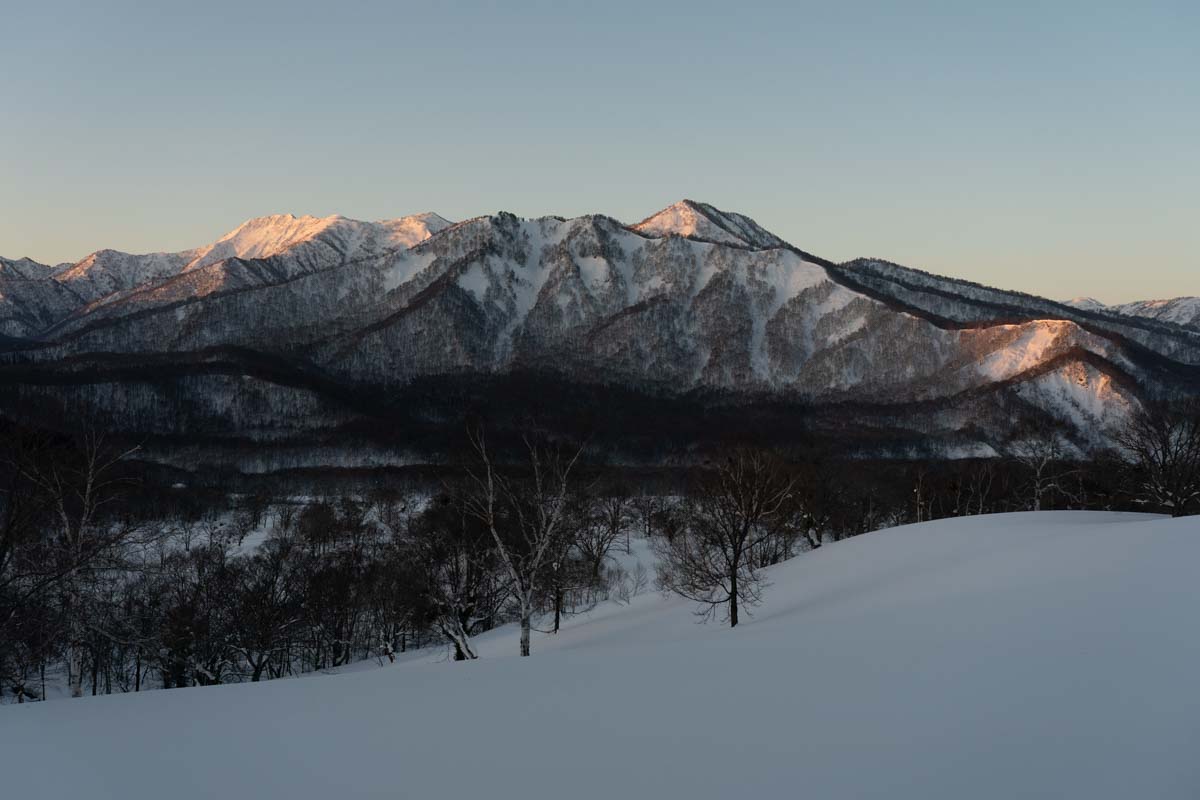
A backcountry run that can be enjoyed only by tour members by approaching areas that have never been visited by people during the harsh winter. Depending on the route selection, it is possible to set various routes from expert to entry.
Next, a snow camp & hike tour where you stay in a tent and ski in the backcountry. A three-day, two-night course is planned for next season, and the first day will be at the campsite. The next day, cross the Sasagamine Dam from the campsite, hike and ski in the area that spreads to the south, and cat out after skiing on the final day. If the weather and conditions permit, you can enjoy different routes on all three days.
In fact, in this pre-operation, we carried out this backcountry tour of staying on snow. Check out the photos and videos to see how good the snow is and how comfortable it is to slide on.
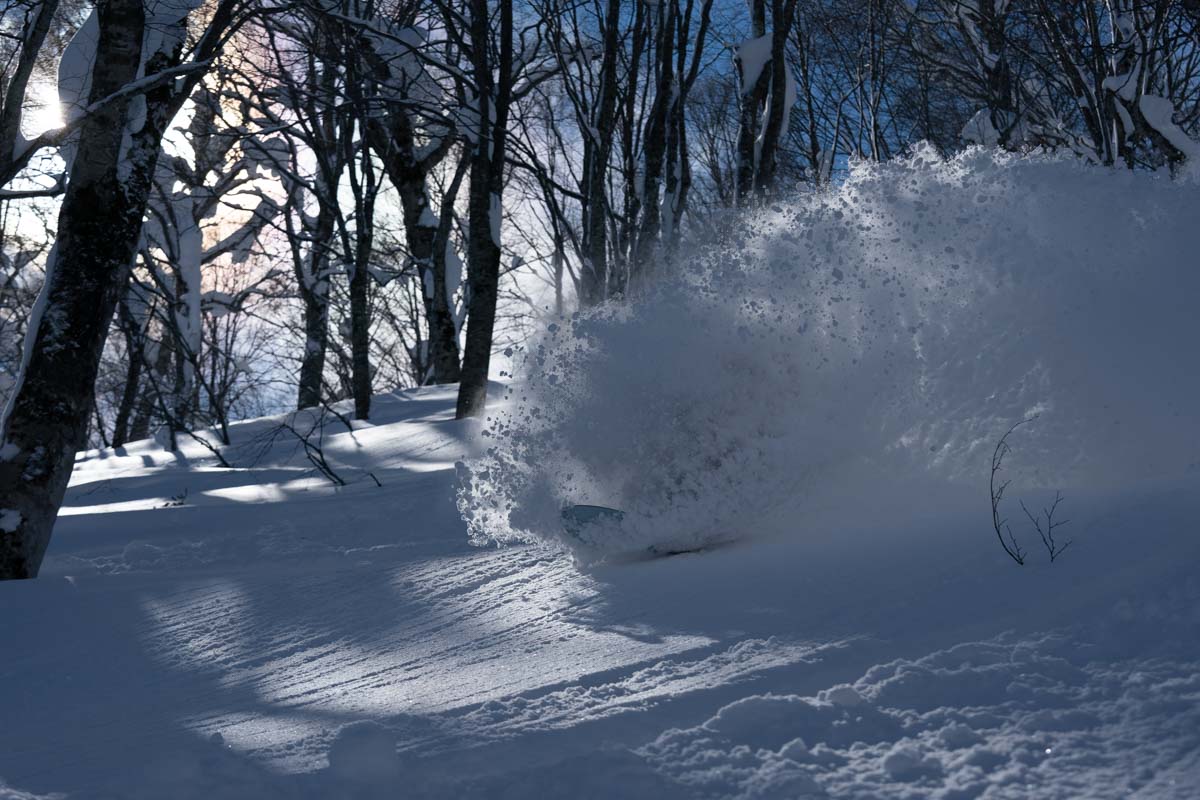
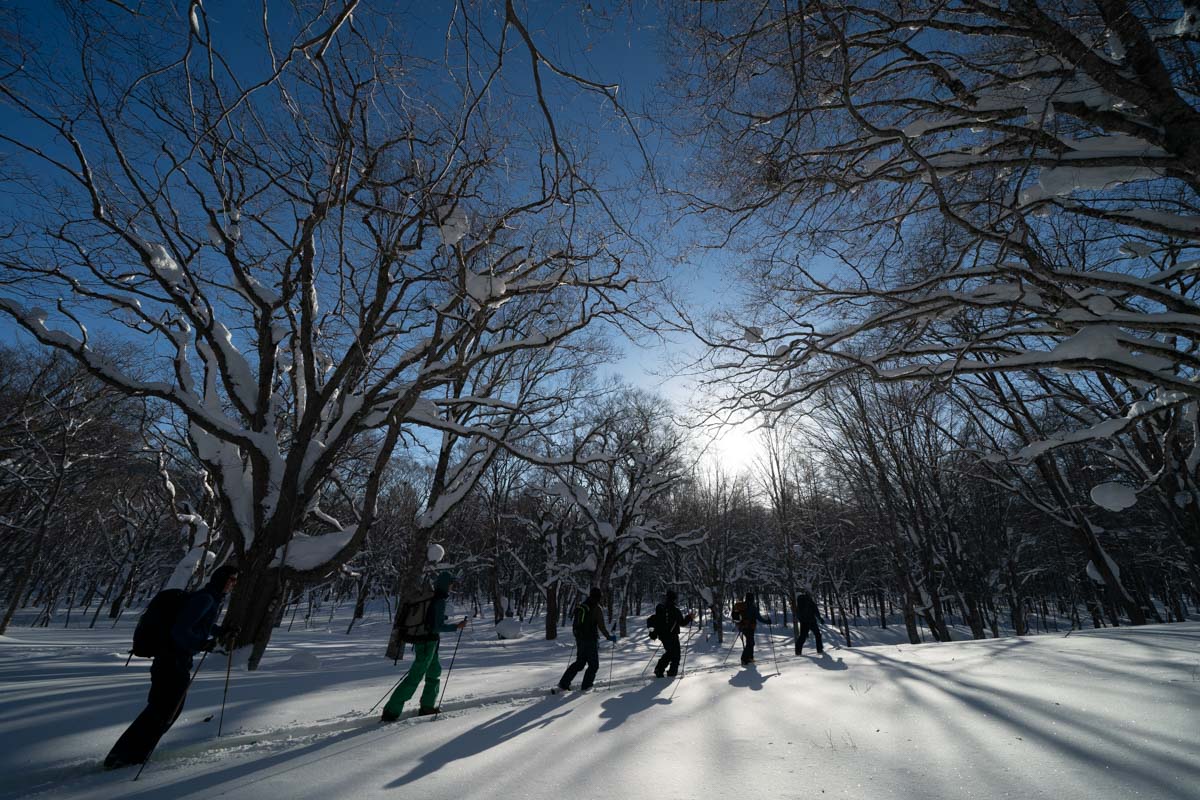
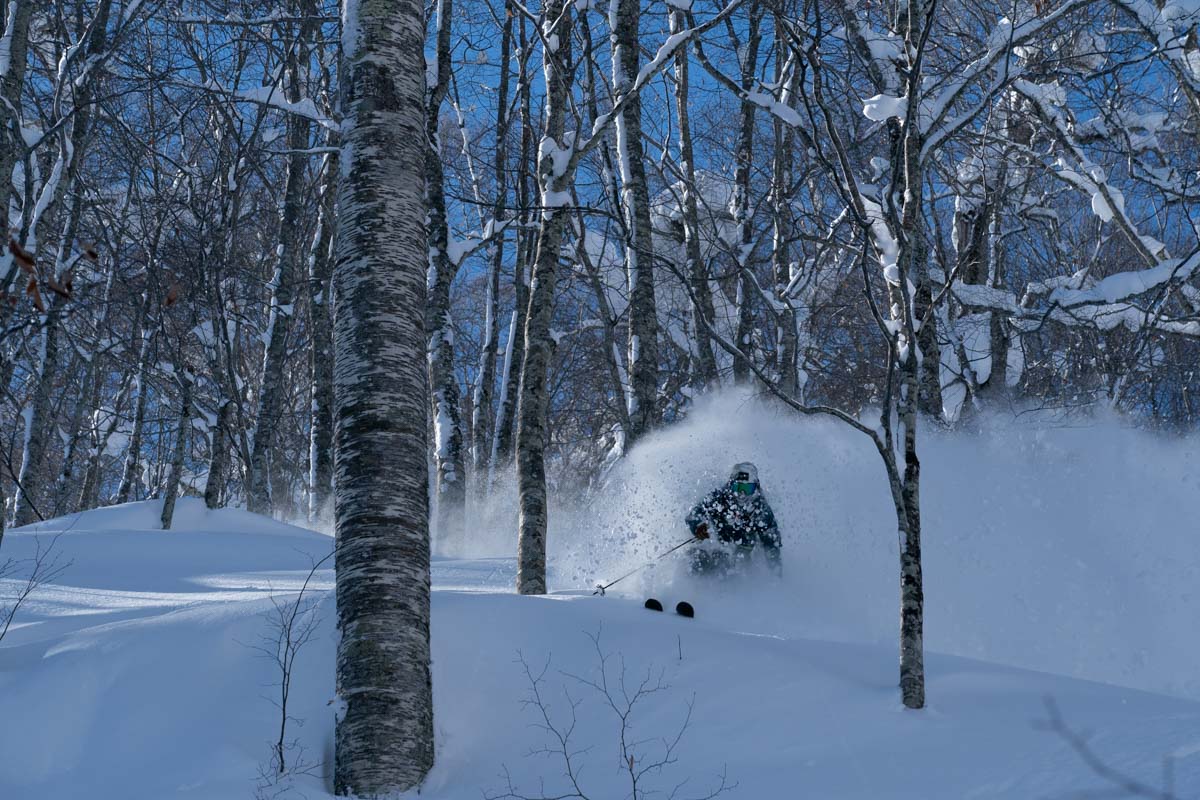
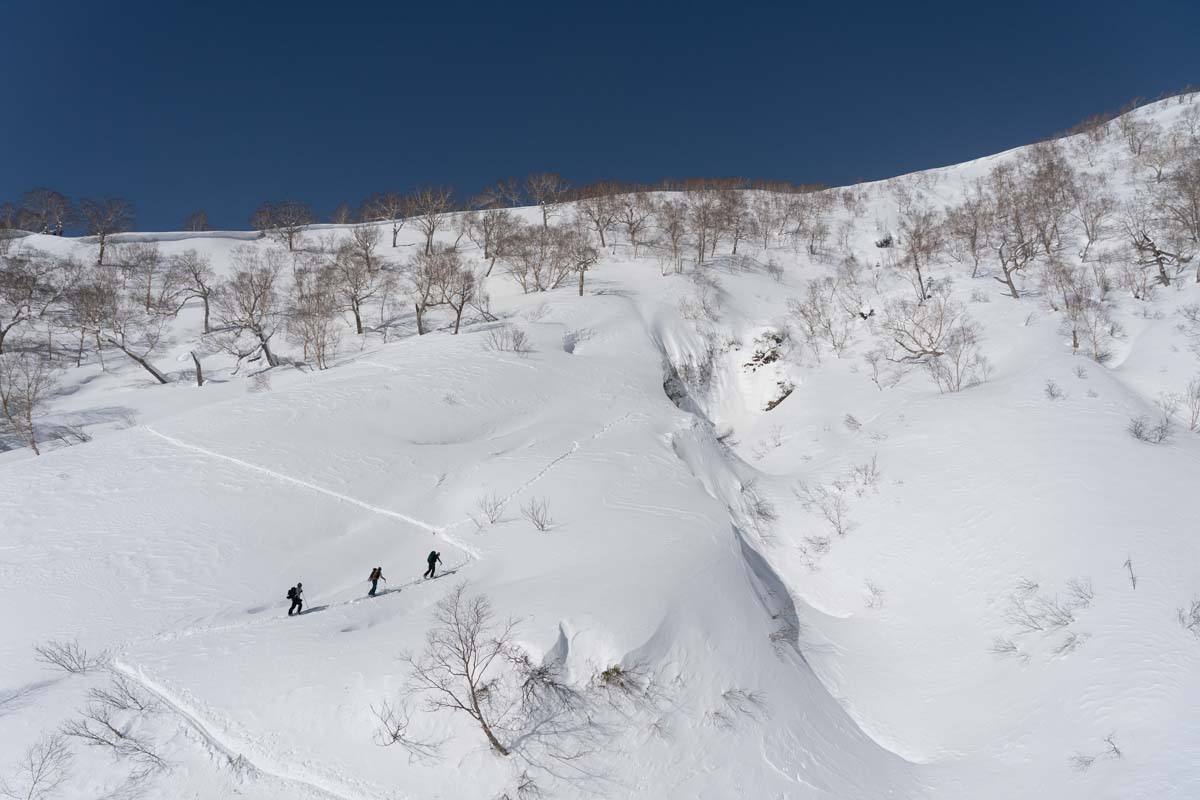
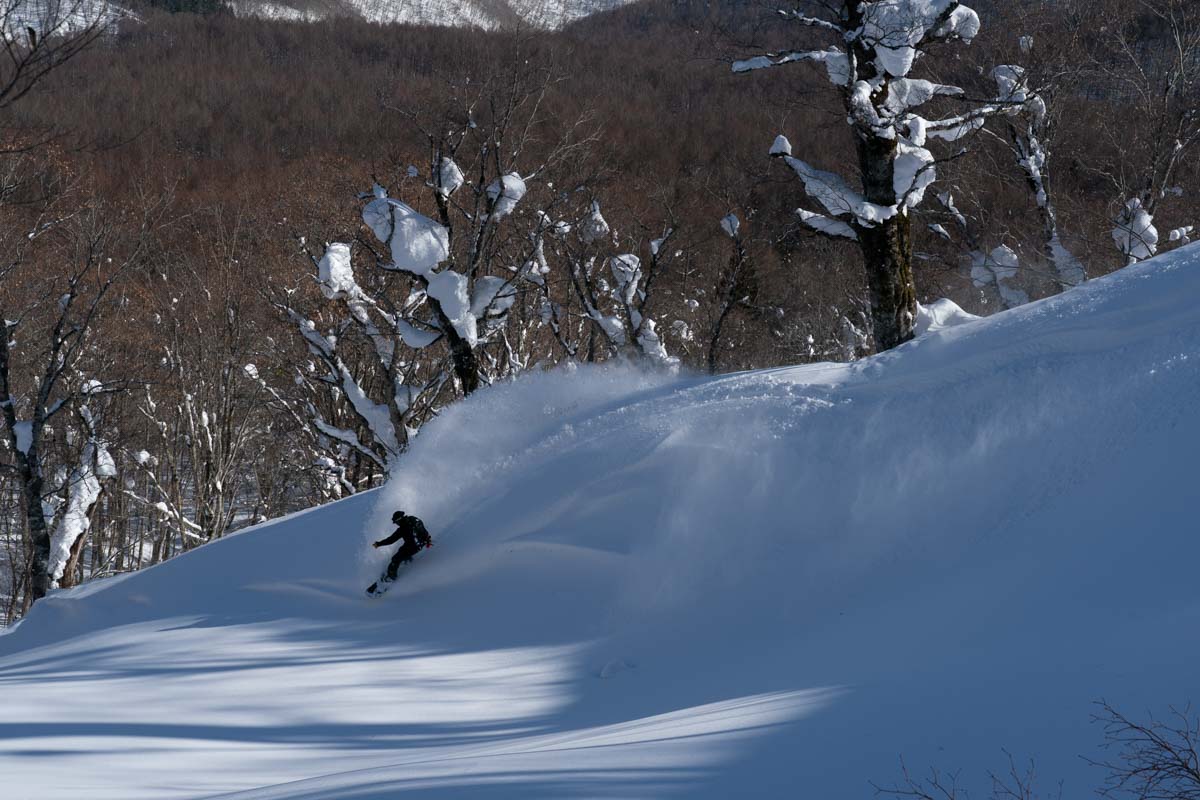
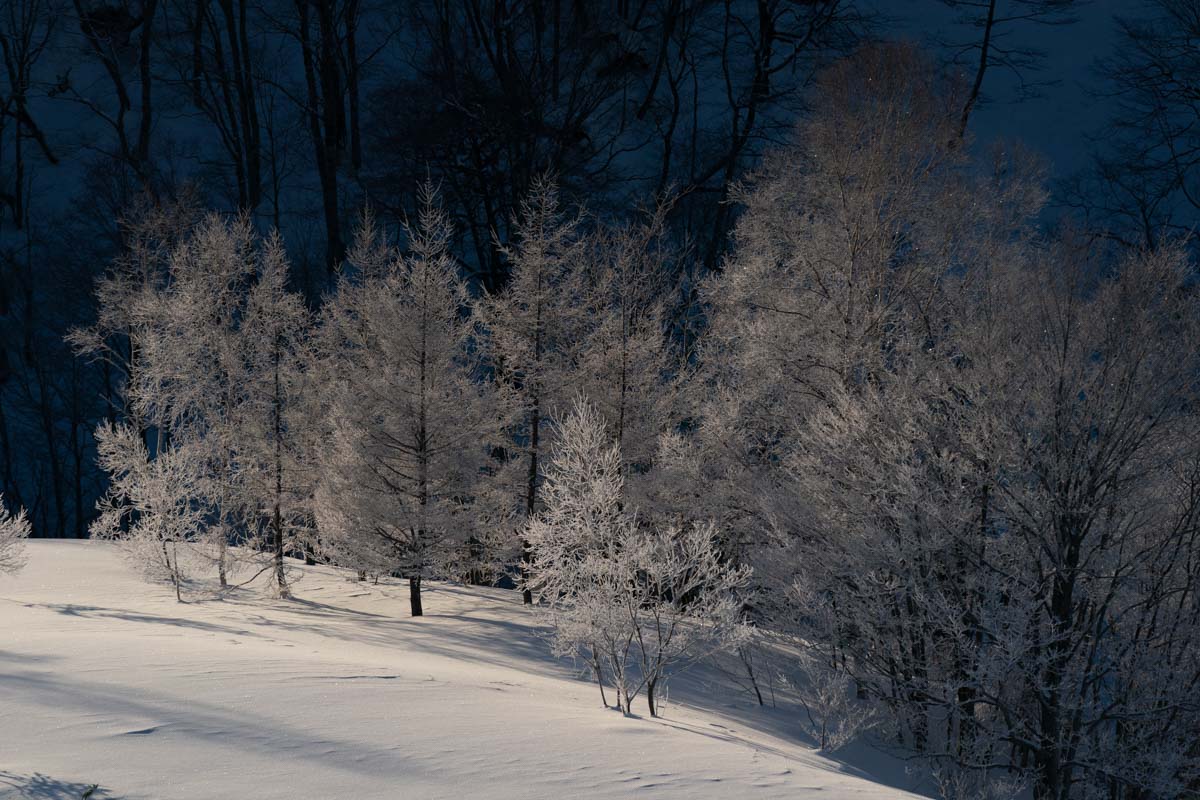
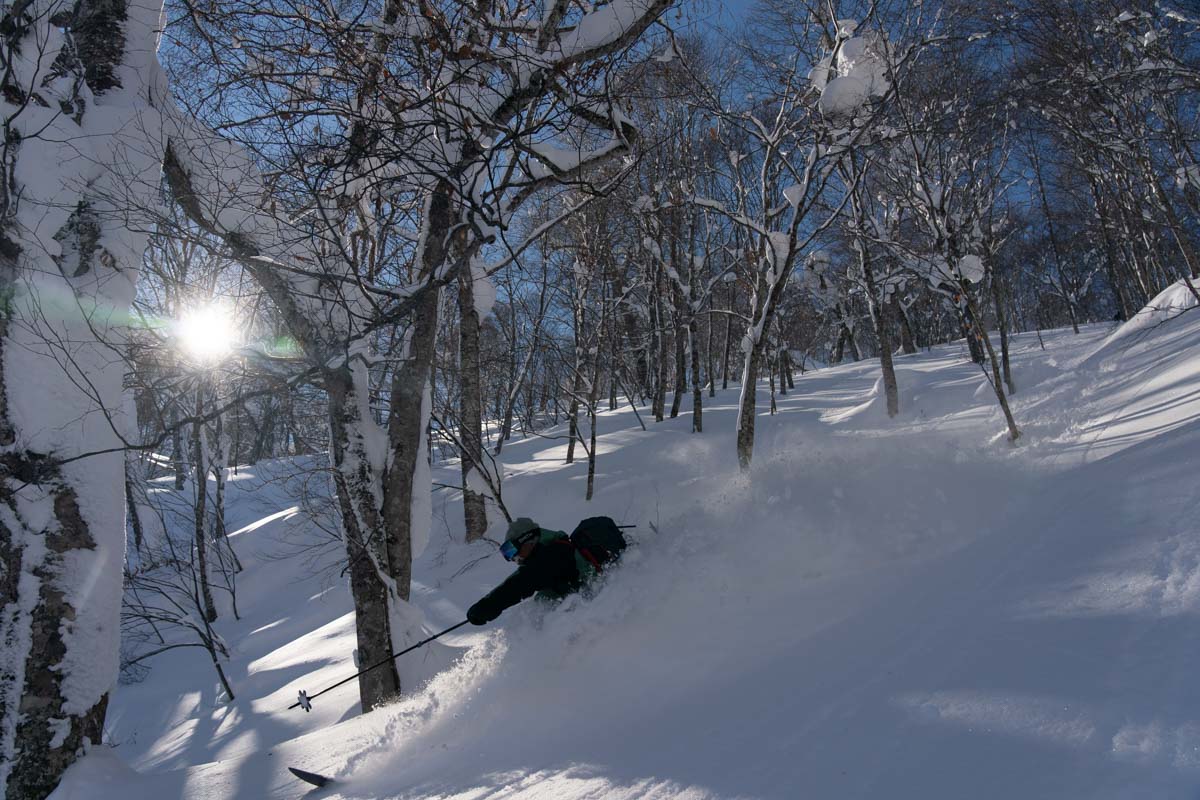
Alternatively, for those who don't backcountry ski/snowboard, the snow camp itself could be combined with a snowshoe hike. There are many highlights such as the spacious area around Sasagamine Ranch, the frozen white Lake Otomi, and the virgin beech forest of Yumemidaira. All of them are guided by ski guides who know the Myoko backcountry inside and out.
Backcountry tour with SBCT full of great possibilities
As a frank impression that I participated in the pre-tour before the full-scale opening, it looks like it will be a very exciting tour. Of course, there is no doubt that it is greatly influenced by the weather and snow conditions, but it is the same in any snow area. On top of that, they will suggest new ways to enjoy Myoko.
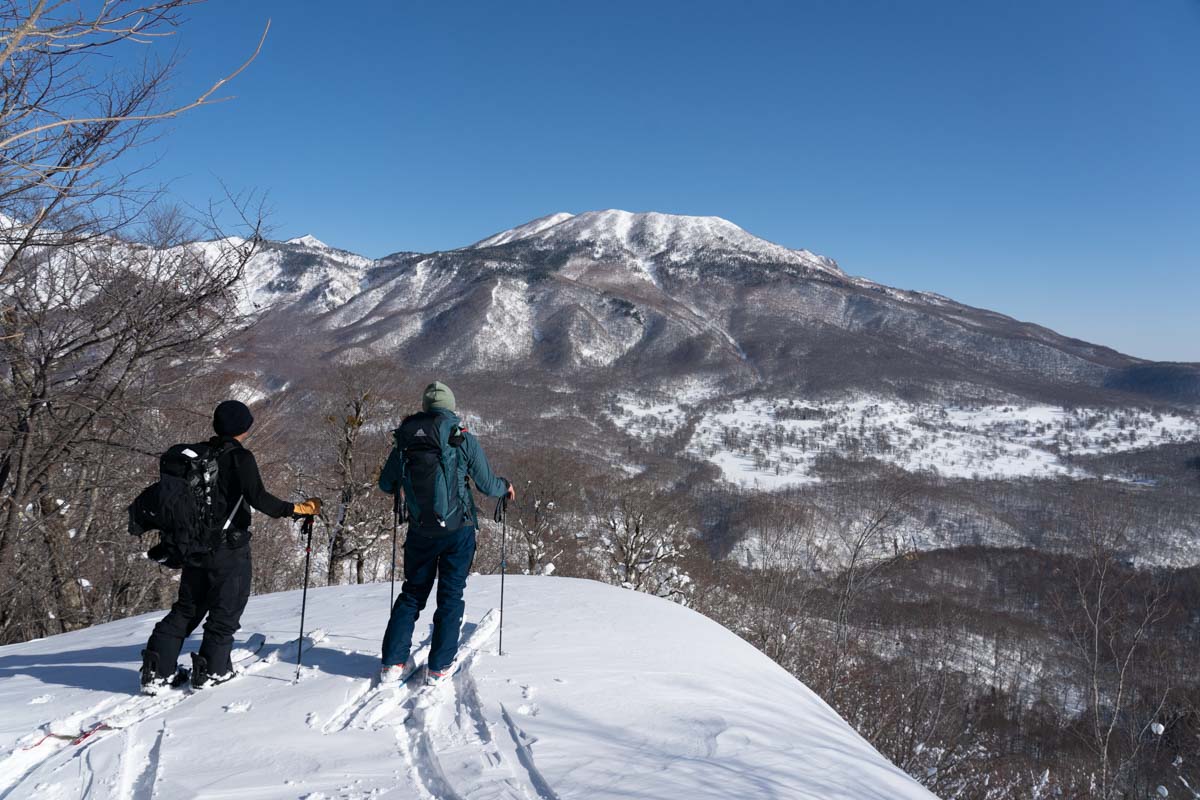
In particular, the Sasagamine Kogen area has been untouched so far, so I was made to feel the possibility of developing new tour routes. That's where we can expect a lot.
For example, as just one example, integration with the Mt. Mitawara tour, which is also a popular route in the Myoko backcountry, can be considered. On a regular Mitawarayama tour, it is common to approach from the top of Myoko Suginohara Ski Resort, ski down the southern slope, and then return to Myoko Suginohara Ski Resort.
However, by having the cat wait at the bottom of the south slope, it is possible to slide down a large elevation difference of around 1000m to the bottom. Then, get on the cat that is picking you up and go to the campsite. If the condition and physical strength allow, the next day is a one-day BC tour that crosses the Sasagamine Dam. And on the last day, after skiing in a nearby area, I finally got on the cat and returned to the Suginosawa parking lot. If the conditions and members are aligned, such a long-run course for good walkers can be realized.
In the future, it can be expected that new tour routes will be developed as the operation of each season progresses. However, no matter how popular it becomes, there is a limit to the capacity of the snowmobile crew, so there is no need to worry about fast track competition or overuse. maintained at This is another major attraction of SBCT.
DATA
Thunderbird Cat Tour Myoko (SBCT)
https://thunderbird-guides.com/
Recruitment start: December 2021 (planned)
Business period: January 1 to March 28, 2021 (mainly weekends)
: myoko.thunderbird.guides@gmail.com
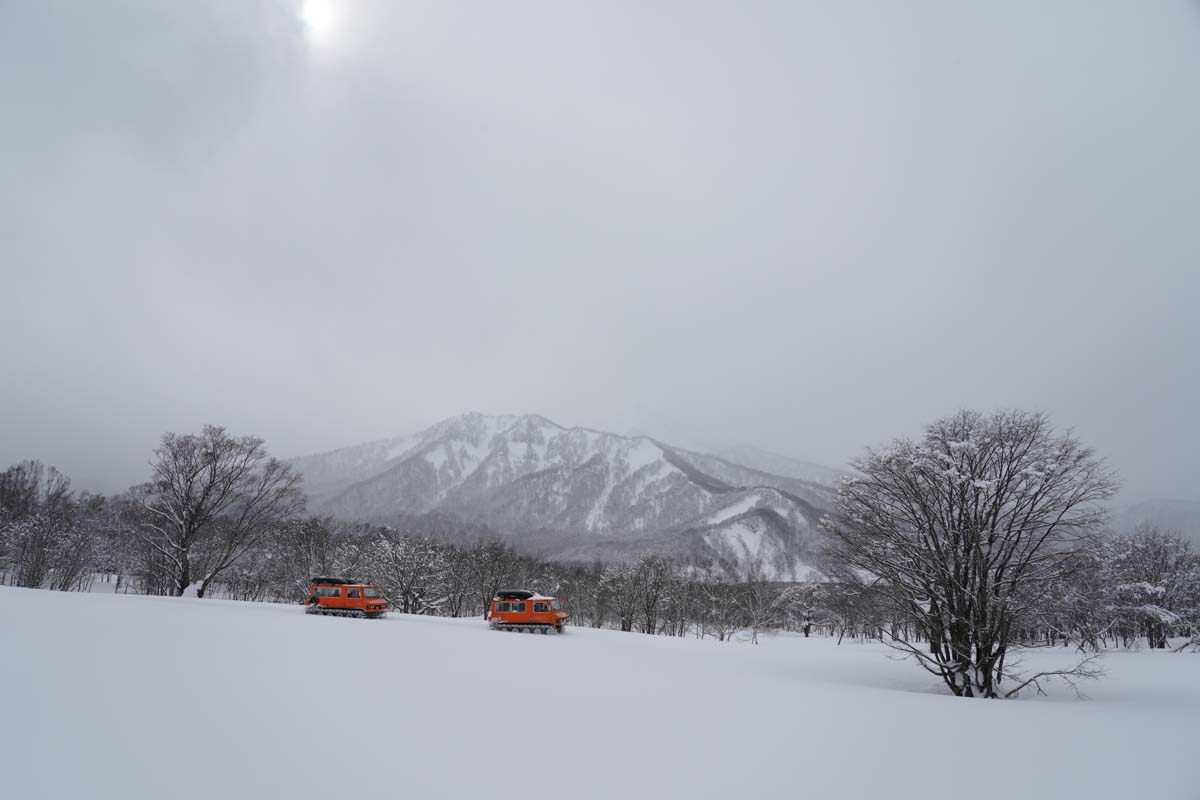
Thunderbird Cat Tour Myoko offers the following three tours, and participants can choose from a variety of snow activities according to their interests, preferences, levels, and goals.
01 Panorama Tour
・Tour to experience the history and culture of Myoko, reusing the former Myoko Kogen Panorama Park ski resort.
・Backcountry skiing/snowboarding, snowshoeing by snowmobile
・Time required is about half a day starting early in the morning
02 Sasagamine Tour
・A one-day tour that approaches Sasagamine Highland by snowmobile and enjoys backcountry skiing/snowboarding and snowshoeing
・Time required is one day starting early in the morning and ending in the evening
03 Sasagamine Base Camp Tour
・Set up a base camp in Sasagamine Highland approached by a snow vehicle, and enjoy a 2-day BC tour while enjoying snow camping
・Backcountry skiing/snowboarding, snowshoeing, snow vehicle tour, snow camp
・Time required 3 days and 2 nights starting early in the morning (planned)
Terakura, Text = Chikara Terakura
Photograph = Jo Kobashi Photo = Joe Kobashi
Video = Ebis Film Movie = ebis films

